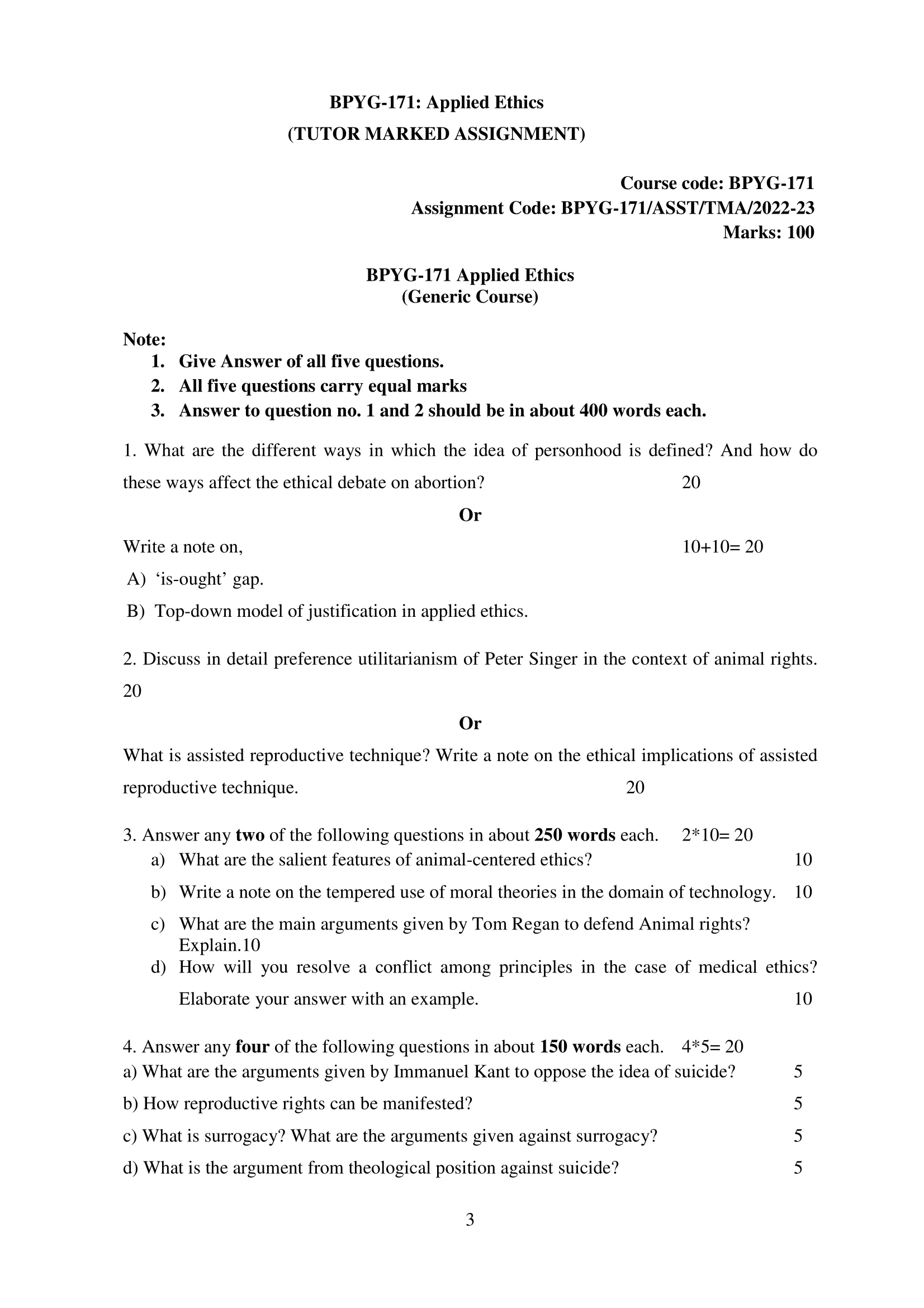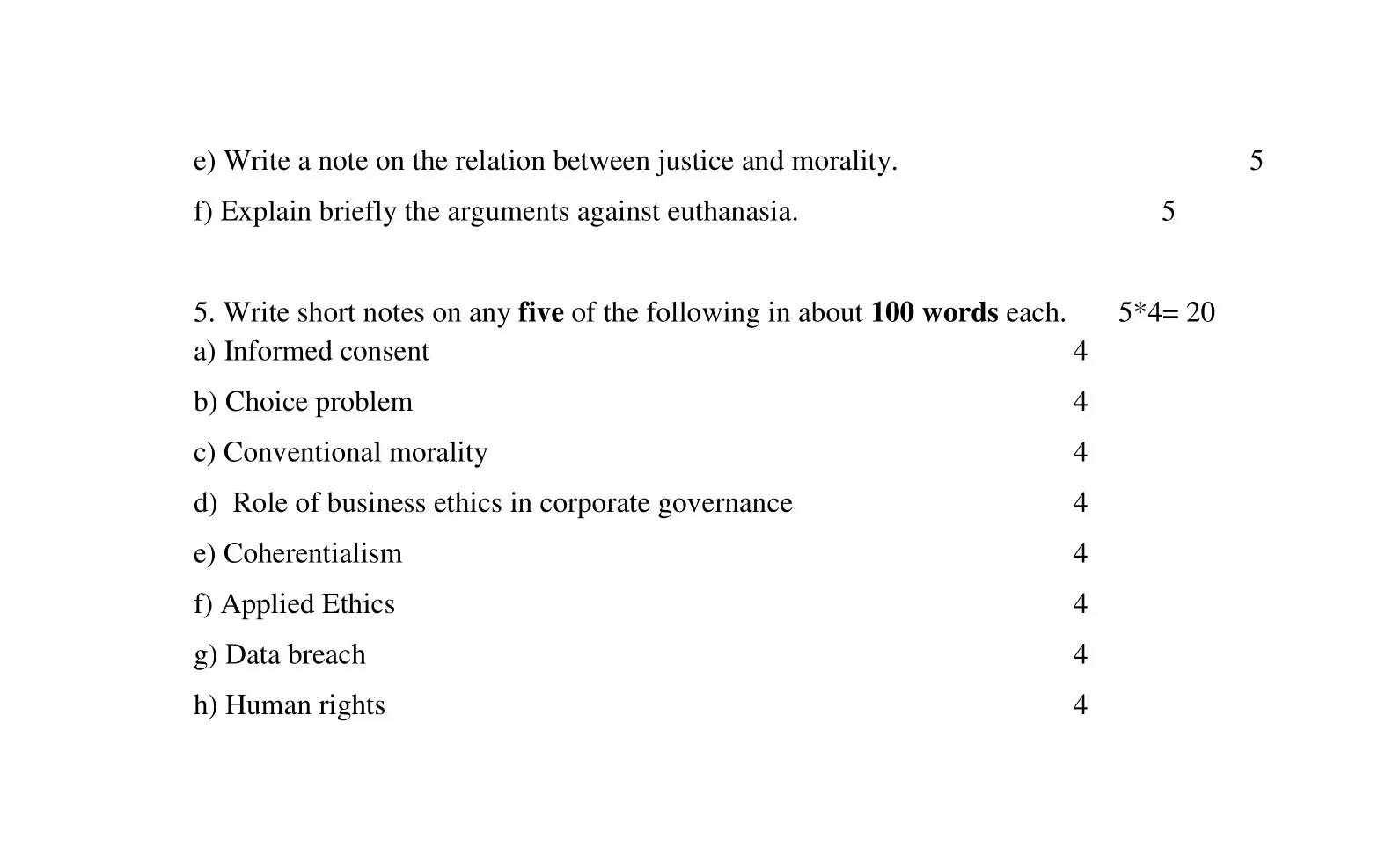
| Title | IGNOU: BPYG-171 Solved Assignment 2022-2023 (Applied Ethics) |
| University | IGNOU |
| Degree | Bachelor Degree Programme |
| Course Code | BPYG-171 |
| Course Name | Applied Ethics |
| Programme Name | Bachelor of Arts (General) |
| Programme Code | BAG |
| Total Marks | 100 |
| Year | 2022-2023 |
| Language | English |
| Assignment Code | BPYG-171/ASST/TMA/2022-23 |
| Last Date for Submission of Assignment: | For June Examination: 31st March For December Examination: 30th September |


1. What are the different ways in which the idea of personhood is defined? And how do these ways affect the ethical debate on abortion?
Ans: Personhood refers to the status or condition of being a person, often with legal and moral implications. There are various ways in which the concept of personhood is defined, which can have a significant impact on the ethical debate surrounding abortion.
- Legal Definition of Personhood: In legal terms, personhood is often defined as the status of being a legal entity with rights, duties, and obligations recognized by the law. In some jurisdictions, fetuses are not considered legal persons, while in others they are. This definition affects the ethical debate on abortion as it determines the extent to which the law recognizes and protects the rights of fetuses.
- Biological Definition of Personhood: From a biological perspective, personhood is defined by the capacity for human life. This definition is based on the idea that personhood begins at conception, when a fertilized egg has the potential to develop into a human being. Those who support this definition argue that abortion is equivalent to taking a human life and is therefore morally wrong.
- Philosophical Definition of Personhood: Philosophers have debated the concept of personhood for centuries, with varying definitions based on criteria such as consciousness, self-awareness, and moral agency. Some argue that personhood begins at conception, while others argue that it only begins after birth or at some point during fetal development. This definition affects the ethical debate on abortion as it influences how individuals view the moral value of a fetus.
- Religious Definition of Personhood: Many religious traditions hold that personhood begins at conception or at some point during fetal development. This definition is based on the belief that a fetus has a soul and is therefore deserving of protection. Those who adhere to this definition argue that abortion is morally wrong because it takes the life of a person.
The different ways in which personhood is defined have a significant impact on the ethical debate surrounding abortion. Those who support the biological or religious definition of personhood tend to view abortion as morally wrong, while those who support the legal or philosophical definition may view it as a matter of personal choice. The outcome of the debate can have far-reaching implications for women’s reproductive rights and the availability of abortion services.
Or
Write a note on:
A) ‘is-ought’ gap.
Ans: The “is-ought” gap refers to the philosophical problem of explaining how statements about what is, or descriptive statements, can be used to support statements about what ought to be, or prescriptive statements. This gap has been a central concern in ethical theory, as it is often difficult to derive normative claims from purely descriptive information.
The “is-ought” gap was first identified by Scottish philosopher David Hume, who argued that it is not logically possible to infer an “ought” statement from an “is” statement. He argued that the only way to support normative claims is through experience and observation of human practices and emotions, not through logical deduction.
Critics of this view argue that the gap can be bridged by appealing to moral principles or rules, which can be used to support prescriptive statements. For example, the principle of non-maleficence, which states that it is wrong to cause harm to others, can be used to support the prescriptive claim that it is wrong to harm others.
Others have argued that the gap can be bridged through a naturalistic approach to ethics, which claims that ethical principles can be derived from scientific observations of human behavior and emotions. This approach argues that ethical claims can be grounded in empirical facts about human nature, and that normative statements can be supported through scientific evidence.
Despite these efforts, the “is-ought” gap continues to be a subject of debate in philosophy, as many philosophers argue that it is not possible to derive normative claims from purely descriptive information. For example, some have argued that ethical claims are not based on empirical evidence, but instead are based on subjective preferences or cultural conventions.
The “is-ought” gap is important in applied ethics, as it has implications for how we approach ethical questions and make moral decisions. If the gap cannot be bridged, then it may be difficult to defend ethical claims or to justify particular courses of action. On the other hand, if the gap can be bridged, then it may be possible to develop a systematic and rigorous approach to ethical decision-making, based on empirical facts and objective principles.
B) Top-down model of justification in applied ethics.
Ans: Top-down model of justification in applied ethics is a philosophical approach to ethical decision-making that starts with a general principle or moral rule and applies it to specific cases. In this model, ethical justifications are made by reference to a set of abstract moral principles, such as the principle of non-maleficence (the duty to do no harm), the principle of beneficrimination (the duty to treat all individuals fairly), or the principle of autonomy (the right of individuals to make their own decisions).
One of the key features of the top-down model is its focus on universality. The moral principles used to make ethical decisions are intended to be applicable across different cultures, times, and situations. This universality helps to ensure that ethical justifications are grounded in a shared moral understanding and can be used to guide decision-making in a consistent and predictable manner.
Another important feature of the top-down model is its emphasis on deductive reasoning. This approach to ethical decision-making begins with a general principle and applies it to a specific case, in order to reach a conclusion about the right course of action. This deductive approach helps to ensure that ethical decisions are made in a systematic and rigorous manner, and that they are based on a logical and well-supported argument.
The top-down model of justification has been applied in a variety of fields, including medical ethics, business ethics, and environmental ethics. In medical ethics, for example, the top-down model is often used to evaluate the ethical implications of medical treatments, such as the use of genetically modified organisms in medical research or the use of human subjects in clinical trials. In business ethics, the top-down model is often used to evaluate the ethical implications of business practices, such as outsourcing and employee exploitation.
Despite its strengths, the top-down model of justification has been criticized for its rigidity and inflexibility. Critics argue that the deductive approach to ethical decision-making can result in ethical justifications that are overly formulaic and insensitive to the complexities of real-world ethical problems. Additionally, the focus on universal principles can lead to ethical justifications that are insensitive to the unique cultural and historical context of specific situations.
In response to these criticisms, some ethicists have proposed alternative models of ethical justification that are more flexible and sensitive to context. One such model is the bottom-up approach, which begins with an examination of the particular facts and circumstances of a specific case, and works upwards to a general principle. This approach is often seen as being more responsive to the unique complexities of real-world ethical problems, and is therefore considered to be a more practical and effective approach to ethical decision-making.
2. Discuss in detail preference utilitarianism of Peter Singer in the context of animal rights.
Ans: Preference utilitarianism is a philosophical approach to ethics developed by philosopher Peter Singer. It is a form of utilitarianism, which holds that the ultimate moral aim is to maximize overall happiness or pleasure and minimize suffering. Preference utilitarianism is distinguished from other forms of utilitarianism in that it focuses on the satisfaction of individual preferences, rather than simply maximizing happiness in general.
In the context of animal rights, Singer’s preference utilitarianism has important implications. Singer argues that animal rights should be based on the satisfaction of the preferences of individual animals, rather than on human moral obligations. He argues that animals, like humans, have preferences and desires, and that these should be taken into account when making ethical decisions about how to treat animals.
According to Singer, animal rights should be based on the idea of equal consideration of interests. This means that the interests of all beings, regardless of species, should be given equal weight in ethical decision-making. For Singer, this means that animals should be granted certain basic rights, such as the right to life and the right to be free from suffering.
Singer’s preference utilitarianism is often used to defend animal rights, as it provides a framework for considering the interests of animals in ethical decision-making. By focusing on the satisfaction of animal preferences, it provides a way of taking into account the well-being of individual animals, rather than simply considering the interests of humans.
One of the key arguments of Singer’s preference utilitarianism is that animals can experience pleasure and pain, and that these experiences should be taken into account when making ethical decisions about how to treat animals. This means that animal welfare should be a primary concern in any decision-making process, as animals are capable of experiencing pleasure and suffering.
Another important aspect of Singer’s preference utilitarianism is the idea of moral equality. Singer argues that all beings, regardless of species, should be treated as equals, and that their interests should be given equal weight in ethical decision-making. This means that animals should be granted the same basic rights as humans, and that their well-being should be taken into account when making ethical decisions about how to treat them.
Or
What is assisted reproductive technique? Write a note on the ethical implications of assisted reproductive technique.
Ans: Assisted Reproductive Techniques (ARTs) refer to a group of medical procedures used to help couples or individuals with infertility to conceive a child. ARTs can include various methods such as in vitro fertilization (IVF), intracytoplasmic sperm injection (ICSI), and gamete intrafallopian transfer (GIFT), among others. The goal of ARTs is to help individuals or couples overcome infertility and have a biological child.
While ARTs have provided many couples and individuals with the opportunity to have children, they also raise a number of ethical questions and concerns. Some of the ethical implications of ARTs include:
- Access to ARTs: One of the major ethical concerns is that ARTs can be expensive and not widely available, making them inaccessible to many people. This raises questions about fairness and justice, as only those who can afford the procedures can benefit from them.
- Multiple pregnancies: ARTs often result in multiple pregnancies, which can pose risks to both the mother and the fetuses. This raises questions about the ethical implications of multiple pregnancies and the potential harm that they can cause.
- Surrogacy: ARTs can involve surrogacy, where a woman carries and delivers a child for another couple or individual. Surrogacy raises a number of ethical concerns, including questions about the exploitation of women, the commodification of children, and the legal rights of the surrogate mother and the intended parents.
- Selective reduction: In cases of multiple pregnancies, selective reduction, or the intentional termination of one or more fetuses, may be necessary for the health of the mother and the remaining fetuses. This raises ethical questions about the value of human life and the morality of intentional termination.
- Egg and sperm donation: ARTs can involve the use of donated eggs or sperm, which raises ethical questions about the rights of the donor, the recipient, and the resulting child. These questions include issues of anonymity, the welfare of the donor, and the potential impact on the child’s identity and well-being.
- Destruction of embryos: ARTs often result in the creation of surplus embryos, which may be stored for future use or discarded. This raises ethical questions about the status and value of embryos, and the morality of their destruction.
3. Answer any two of the following questions in about 250 words each.
a) What are the salient features of animal-centered ethics?
Ans: Animal-centered ethics is a philosophical framework that argues that non-human animals should be accorded moral consideration and protection. It recognizes that animals have interests, desires, and experiences that should be respected and considered in moral decision making.
- Recognition of animal sentience: Animal-centered ethics acknowledges that animals are sentient beings capable of feeling pleasure, pain, and suffering. This is a departure from traditional Western ethics, which often views animals as mere things or resources.
- Interests of animals: In animal-centered ethics, the interests of animals are considered on an equal footing with the interests of human beings. This means that the welfare of animals should not be subordinated to human desires or interests.
- Moral consideration: Animal-center ethics requires that we consider the moral implications of our actions towards animals. This means that we should not cause harm to animals without good reason, and that we should respect their dignity and autonomy.
- Avoidance of unnecessary harm: Animal-center ethics requires that we avoid causing unnecessary harm to animals. This includes not using animals for food, clothing, entertainment, or experimentation if alternative options are available.
- Respect for animal dignity: Animal-center ethics recognizes that animals have inherent value, independent of their usefulness to human beings. This means that animals should not be treated as mere commodities, but as beings deserving of respect and dignity.
- Environmental ethics: Animal-center ethics is also concerned with the impact of human activities on the natural environment and the welfare of other species. This requires us to adopt sustainable practices and to minimize our impact on the environment.
b) Write a note on the tempered use of moral theories in the domain of technology.
Ans: The use of moral theories in technology has become increasingly relevant in recent years. As technology advances and becomes more integrated into our daily lives, it is important to consider the ethical implications of these innovations. Moral theories provide a framework for understanding what is right and wrong in human behavior, and they can help us make decisions about the development and use of technology.
However, the use of moral theories in technology must be tempered. This means that moral theories should not be applied blindly or dogmatically. Instead, they should be used in a flexible and nuanced way that takes into account the complexities and uncertainties of the technological world.
One of the key challenges in using moral theories in technology is to find a balance between competing values and interests. For example, privacy and security are both important values, but they may come into conflict with one another. In such cases, it is important to use moral theories to weigh the relative importance of these values and make informed decisions about how to balance them.
Another challenge is to consider the broader social and cultural context in which technology is used. Moral theories must be adapted to the particular cultural, historical, and political context in which they are applied. This means that the same technology may have different ethical implications in different contexts, and that moral theories must be flexible enough to accommodate these differences.
c) What are the main arguments given by Tom Regan to defend Animal rights? Explain.
Ans: Tom Regan was an American philosopher who defended animal rights. He believed that animals have inherent value and should be treated with respect, just as humans are. His arguments for animal rights centered around three key points: the subject-of-a-life criterion, the rights view, and the harm principle.
Firstly, Regan argued that animals are subjects-of-a-life, meaning that they have experiences and consciousness and are therefore deserving of moral consideration. Regan believed that animals are not just things to be used for human benefit, but are beings with their own interests and desires.
Secondly, Regan maintained that animals have moral rights, just as humans do. He argued that animals have the right to be treated with respect and not to be used as mere objects for human benefit. According to Regan, animals have a right to life, a right not to be treated cruelly, and a right to pursue their own interests.
Finally, Regan introduced the harm principle, which states that it is wrong to cause harm to others, regardless of whether they are human or non-human. He believed that humans have a moral obligation to avoid causing harm to animals and to respect their rights. He argued that this harm principle is universal and should apply to all beings, regardless of their species.
d) How will you resolve a conflict among principles in the case of medical ethics? Elaborate your answer with an example.
Ans: Conflict among principles is a common issue in medical ethics, and resolving these conflicts requires a systematic and thoughtful approach. One of the key strategies for resolving conflicts in medical ethics is to prioritize the principles involved, taking into account the moral significance and the impact of each principle on the situation at hand.
For example, consider a case where a patient is in need of a life-saving procedure, but the only available organ for transplant is from a deceased individual who was not a registered organ donor. On one hand, the principle of autonomy states that patients have the right to make decisions about their own medical treatment. On the other hand, the principle of justice requires that organs be distributed fairly and equitably, and that the deceased person’s wishes regarding organ donation be respected.
In this scenario, the conflict between autonomy and justice can be resolved by prioritizing the principle of saving a human life. The patient’s autonomy is still respected because they have the right to make decisions about their medical treatment, but the principle of justice is also upheld by procuring the organ in an ethical manner and respecting the deceased person’s wishes, if possible.
It’s important to note that this is a complex issue, and that there may be additional principles or values that come into play, such as beneficrimination, privacy, informed consent, and more. In such cases, it may be necessary to engage in a more thorough ethical analysis and seek advice from a multidisciplinary team, including ethicists, medical professionals, and legal experts.
4. Answer any four of the following questions in about 150 words each.
a) What are the arguments given by Immanuel Kant to oppose the idea of suicide?
Ans: Immanuel Kant was a German philosopher who opposed the idea of suicide. He believed that suicide was morally wrong and that it violated the intrinsic value of human life. According to Kant, the value of human life is not dependent on external circumstances or individual preferences, but rather is a inherent and unconditional value.
Kant argued that suicide is a violation of the moral law because it involves a person taking their own life, which is considered a universal and absolute good. He believed that human life is sacred and that individuals have a moral obligation to preserve and respect it.
Additionally, Kant argued that suicide is a form of self-harm and that individuals have a duty to maintain their own life and physical well-being. He believed that individuals have a responsibility to care for their own health and well-being, and that suicide is a failure to fulfill this duty.
b) How reproductive rights can be manifested?
Ans: Reproductive rights refer to the rights of individuals to make decisions about their own reproductive health and well-being. These rights include the right to access safe and legal abortion, access to contraception, and the right to make decisions about family planning without interference from others.
Reproductive rights can be manifested through laws and policies that protect individuals’ autonomy in making decisions about their own bodies. This includes legislation that guarantees access to safe and legal abortion, as well as policies that ensure access to affordable contraception and comprehensive sexuality education.
In addition, reproductive rights can be manifested through the provision of quality healthcare services, including prenatal and postnatal care, that support individuals and families throughout the reproductive lifespan. This includes access to reproductive health information, counseling, and services, as well as the availability of modern methods of family planning.
Moreover, reproductive rights can also be manifested through cultural norms and attitudes that respect individuals’ autonomy and bodily integrity, and that challenge the stigma and discrimination associated with reproductive health and rights. This includes promoting gender equality and empowering women and girls to make informed choices about their own reproductive health.
Ultimately, the manifestation of reproductive rights requires a comprehensive approach that involves legal protections, healthcare access, and cultural change.
c) What is surrogacy? What are the arguments given against surrogacy?
Ans: Surrogacy is a form of assisted reproductive technology in which a woman carries and gives birth to a child for another person or couple. There are two main types of surrogacy: traditional surrogacy, in which the surrogate is the biological mother of the child, and gestational surrogacy, in which the surrogate carries an embryo created using the intended parents’ or donors’ eggs and sperm.
Opponents of surrogacy argue that it commodifies women’s bodies and exploits them for their reproductive abilities. They also argue that surrogacy can lead to the objectification and exploitation of children, as they are seen as commodities to be bought and sold. In addition, some critics argue that surrogacy perpetuates patriarchal norms and reinforces the idea that women’s bodies are primarily for the benefit of others.
Another argument against surrogacy is that it can have negative psychological and emotional effects on both the surrogate and the intended parents, particularly if the surrogacy arrangement is not handled with sensitivity and care. Furthermore, some opponents argue that surrogacy undermines the traditional understanding of family and parenthood, and could lead to the erosion of family values and the creation of new forms of social inequality.
Lastly, there are also concerns about the regulation and enforcement of surrogacy contracts, as well as the lack of uniform laws and policies governing surrogacy across different countries, which can lead to exploitation and abuse.
d) What is the argument from theological position against suicide?
Ans: The argument from a theological position against suicide is based on the belief that life is a gift from a higher power, such as God, and that taking one’s own life is a violation of that gift.
From this perspective, suicide is considered a sin because it goes against the divine plan for a person’s life, and it interferes with God’s sovereignty over the timing and manner of a person’s death. In some religious traditions, suicide is seen as a denial of faith and an act of despair, which can have serious spiritual consequences, such as exclusion from the afterlife or a longer period of punishment in the afterlife.
Moreover, some religious traditions view suicide as a violation of the commandment “Thou shalt not kill”, which prohibits taking the life of another human being, as well as one’s own life. From this perspective, suicide is seen as a form of self-murder, and it is considered a serious moral breach.
Additionally, many religious communities offer support and care for those who are struggling with suicidal thoughts, and they view suicide prevention as a spiritual duty. For example, some religious leaders and organizations provide counseling, support groups, and spiritual guidance to help individuals overcome their feelings of hopelessness and despair.
e) Write a note on the relation between justice and morality.
Ans: Justice and morality are closely related concepts that refer to principles that govern human behavior and relationships. However, while justice is primarily concerned with the fair and equal distribution of goods and benefits, morality refers to a set of moral principles and values that govern individual behavior and choices.
In a just society, individuals are treated fairly and equitably, and the laws and institutions of the society are designed to promote equality and protect the rights and interests of all citizens. In contrast, morality is concerned with the individual’s conduct and choices, and it provides guidance for right and wrong behavior.
Both justice and morality play an important role in shaping the social and political order, and they are closely interrelated. A just society must be based on moral principles, such as fairness, equality, and respect for human dignity, and individuals must act in accordance with these principles in order to maintain a just society.
In addition, justice and morality also intersect in their approach to the treatment of others. Both principles require individuals to treat others with dignity, respect, and fairness, and they both seek to promote the well-being and happiness of others.
f) Explain briefly the arguments against euthanasia.
Ans: Euthanasia, also known as assisted dying, is a highly controversial issue, and there are several arguments against its legalization.
One argument is that euthanasia goes against the intrinsic value of human life and violates the sanctity of life. From this perspective, taking a life, even if it is to end suffering, is morally wrong and goes against the fundamental moral principle that human life is precious and should be protected.
Another argument is that euthanasia could lead to abuse and exploitation, particularly among vulnerable individuals such as the elderly, disabled, and people with chronic illnesses. This is because euthanasia could be used as a means to eliminate those who are seen as a burden to society, rather than as a means to alleviate suffering.
Opponents of euthanasia also argue that it undermines the importance of palliative care, which is designed to provide comfort and relieve the suffering of patients near the end of life. They believe that euthanasia diverts resources and attention away from improving palliative care, and it sends a message that suffering is unacceptable and that death is the only solution.
Furthermore, some people argue that euthanasia could be misused as a form of covert euthanasia, in which patients are given lethal injections without their consent. This could lead to the abuse of power by healthcare providers and a violation of patients’ autonomy and dignity.
5. Write short notes on any five of the following in about 100 words each.
a) Informed consent
Ans: Informed consent is a concept in medical ethics that refers to a patient’s right to make an informed decision about their medical treatment. This involves providing patients with accurate and complete information about the nature of their condition, the risks and benefits of various treatment options, and any alternatives available.
Informed consent requires that patients have the capacity to understand the information provided, and to make a decision based on that information. Patients must also be given enough time to consider their options, and to ask any questions they may have.
The purpose of informed consent is to respect the autonomy and dignity of patients, and to ensure that they are fully involved in making decisions about their own healthcare. It also helps to reduce the risk of medical errors and unintended consequences, and to promote trust and confidence in the healthcare system.
Informed consent is a fundamental principle of medical ethics, and it is recognized as a legal and moral obligation in many countries. Health care providers are required to obtain informed consent from patients prior to any medical procedures or treatments.
b) Choice problem
Ans: The choice problem is a philosophical dilemma that arises when individuals are faced with multiple options and must make a decision. It involves the challenge of determining the best option given limited information, conflicting values, and uncertainty.
In some cases, the choice problem is further complicated by the presence of conflicting values or conflicting goals, making it difficult to determine what the right or optimal choice is. The decision-making process can be influenced by a variety of factors, including personal values, beliefs, and emotions, as well as social and cultural norms.
One of the key challenges of the choice problem is the difficulty in predicting the outcome of a decision, and in weighing the potential benefits and drawbacks of each option. This can lead to feelings of indecision and uncertainty, and to the need to make trade-offs between competing values and goals.
The choice problem is relevant to a wide range of domains, including ethics, economics, political science, psychology, and sociology, and it has been the subject of much debate and research over the years.
c) Conventional morality
Ans: Conventional morality refers to the accepted norms, values, and beliefs about what is right and wrong that are widely held in a particular society or culture. These moral principles often derive from cultural, religious, and historical traditions, and they shape the way individuals think about and act in the world.
Conventional morality is often viewed as distinct from personal or individual morality, which reflects the individual’s own beliefs and values about right and wrong. Conventional morality is often more general and less personal, and it may be more influenced by social, cultural, and historical factors.
The role of conventional morality can vary across cultures and societies, and it can change over time as cultural, social, and historical conditions change. For example, conventional morality may change in response to new scientific discoveries, changing social attitudes, and new laws and policies.
d) Role of business ethics in corporate governance
Ans: Business ethics play a critical role in corporate governance by guiding the behavior of individuals and organizations within the business world. Corporate governance refers to the set of processes, principles, and values that govern the behavior of companies and ensure that they operate in a responsible and ethical manner.
Business ethics provide the framework for decision-making within organizations and help to ensure that decisions are made in the best interests of all stakeholders, including employees, customers, shareholders, and society as a whole. This can include issues related to transparency, accountability, fairness, and responsibility.
The incorporation of business ethics into corporate governance helps to build trust and credibility with stakeholders and promotes a positive reputation for the company. It can also lead to increased profitability and long-term success by ensuring that the company operates in a sustainable and responsible manner.
e) Coherentialism
Ans: Coherentialism is a philosophical theory in ethics that holds that moral truth is based on the coherence of a person’s overall moral beliefs and principles. It asserts that moral truths are not objectively verifiable, but instead, they are grounded in the internal consistency of an individual’s moral system. In other words, coherentialism asserts that moral truths are relative to the individual, and that what counts as morally right or wrong is determined by the coherence of an individual’s moral beliefs and principles. According to coherentialism, moral reasoning involves testing and refining our moral beliefs so that they are logically consistent and coherent with one another. This theory contrasts with other ethical theories such as deontology, consequentialism, and virtue ethics, which assert that moral truths are objective, universal, and based on certain duties, consequences, or virtues.
f) Applied Ethics
Ans: Applied ethics is a branch of ethical theory that deals with the practical and real-world applications of moral principles and values. It involves the examination of ethical issues arising in various fields, such as medicine, business, technology, and the environment, among others. The goal of applied ethics is to provide practical guidance for decision-making and to help individuals and organizations make ethical choices in complex and challenging situations. It involves analyzing the relevant ethical principles and values, considering the interests of all relevant parties, and weighing the potential consequences of different courses of action. Some of the key areas of applied ethics include bioethics, professional ethics, and environmental ethics, among others. The study of applied ethics helps individuals and organizations to reflect on the moral implications of their actions and to act in a manner that is consistent with their values and principles.
g) Data breach
Ans: A data breach is an unauthorized access or release of sensitive information, such as personal information or confidential business data, from a secure system. Data breaches can occur due to hacking, phishing attacks, malware, or human error, among other causes. The consequences of a data breach can be severe, including financial loss, identity theft, reputational damage, and loss of trust in the affected organization. To prevent data breaches, it is important for organizations to have strong security measures in place, such as encryption, firewalls, and employee training programs. It is also important for individuals to protect their personal information by being cautious about sharing sensitive information online and using strong passwords. In the event of a data breach, organizations and individuals should take prompt action to contain and mitigate the damage and prevent future breaches from occurring.
h) Human rights
Ans: Human rights are inherent and inalienable rights that all individuals are entitled to simply because they are human. These rights include the right to life, liberty, and security of person; freedom from discrimination; freedom of thought, conscience, and religion; and the right to participate in government and public affairs. Human rights are universal and apply to all individuals, regardless of race, gender, nationality, ethnicity, religion, or any other status. They are recognized and protected by international law, including the Universal Declaration of Human Rights, and are essential for ensuring dignity, equality, and justice for all people. It is the responsibility of governments and societies to respect, protect, and fulfill these rights for everyone.
How to Download BPYG-171 Solved Assignment 2022-2023 (Applied Ethics) Solved Assignment?
You can download it from the www.edukar.in, they have a big database for all the IGNOU solved assignments.
Is the BPYG-171 Solved Assignment 2022-2023 (Applied Ethics) Solved Assignment Free?
Yes this is absolutely free to download the solved assignment from www.edukar.in
What is the last submission date for (IGNOU-BAG) Solved Assignment?
For June Examination: 31st March, For December Examination: 30th September







